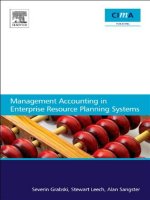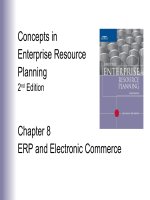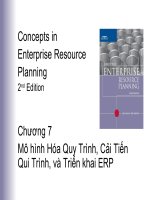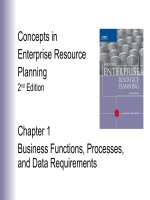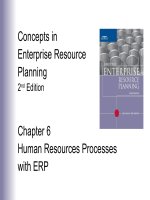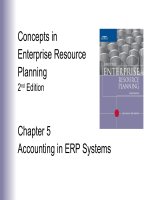Lecture concepts in enterprise resource planning (2nd edition) chapter 8 ERP and electronic commerce
Bạn đang xem bản rút gọn của tài liệu. Xem và tải ngay bản đầy đủ của tài liệu tại đây (296.49 KB, 35 trang )
Concepts in
Enterprise Resource
Planning
2nd Edition
Chapter 8
ERP and Electronic Commerce
Chapter Objectives
• Describe business-to-business e-commerce
• Explain why ERP is essential to the success of a
company engaged in e-commerce
• Describe what an application service provider (ASP)
does
• Describe how ERP is delivered to users by an ASP
• Describe Web services and SAP’s NetWeaver
• Describe the unique components of NetWeaver
• Explain why accessing an ERP system through a Web
browser is efficient
• Define XML and its significance to ERP
• Define RFID and its future role in logistics and sales
Concepts in Enterprise Resource Planning, Second Edition
2
Introduction
• Competing effectively in high-volume e-commerce may
not be possible without the infrastructure provided by
ERP
• Integrating ERP systems with the Internet is becoming
easier with new technologies like Web services and XML
• ERP systems are becoming more affordable as smaller
companies “rent” ERP services
Concepts in Enterprise Resource Planning, Second Edition
3
Electronic Commerce Background
• E-commerce is the conduct of business over the internet
• Most business growth on the Internet has been
business-to-business (B2B) e-commerce, rather than
business-to-consumer (B2C) e-commerce
• B2B sales are expected to approach $1 Trillion in
Europe by 2006
• B2B e-commerce is transforming the way companies
work with each other—especially for commodity
products
Concepts in Enterprise Resource Planning, Second Edition
4
Electronic Data Interchange (EDI)
• Companies have been able to transfer purchase
orders electronically since the 1960s through a
system known as Electronic Data Interchange (EDI),
originally using telephone lines
• EDI networks are expensive, so many companies
subscribe to value-added networks (VAN), an
intermediary Internet-based network
• EDI messages are standardized business
transactions that follow a specific computer protocol
Concepts in Enterprise Resource Planning, Second Edition
5
Electronic Data Interchange (EDI)
• Benefits of EDI include:
• Costs of paper, printing, and postage have almost
disappeared
• Errors are minimized as orders are not manually
entered into the supplier’s information system
• Ordering is fast and efficient
• Large companies may require suppliers to use
EDI, and may pay EDI costs for small suppliers
• EDI tends to lock buyers and suppliers into a longterm relationship
• An advantage as long as both parties remain
satisfied
Concepts in Enterprise Resource Planning, Second Edition
6
Internet-Based Procurement
• Internet-based procurement:
• Is less expensive than private EDI networks
• Reduces purchasing costs further as suppliers
compete for orders on the buyer’s Web site
• Locking in suppliers often does not occur in Internetbased procurement
• Internet-based procurement has led to electronic
marketplaces
• Marketplaces provide advantages for both buyers and
sellers
• Exchanges are B2B marketplaces that typically focus
on a single industry
Concepts in Enterprise Resource Planning, Second Edition
7
ChemConnect.com
• Buyers and sellers of chemical products can use the
ChemConnect marketplace
• Buyers can find the best prices without traditional
negotiations
• Contracts are completed faster between buyers and
sellers
• Buyers and sellers can gain access to new worldwide
markets and trading partners
• Instant market information is available to all parties
Concepts in Enterprise Resource Planning, Second Edition
8
Private Exchanges
• Companies like Siemens, Volkswagen and IBM have set
up private exchanges
• Membership is restricted to select participants
• Volkswagen has slashed procurement costs in half
and cut negotiations from three months to a day
• Jupiter Research estimates that one-third of all
businesses with revenues over $1 billion will operate
private exchanges
Concepts in Enterprise Resource Planning, Second Edition
9
Internet Auctions and Reverse Auctions
• Companies can use standard auctions to sell products or
obsolete equipment
• Reverse auctions, with one buyer and many sellers, can
be used to purchase commodity products that are widely
available at recognized quality standards
• Internet auctions are challenging the role previously
filled by traditional intermediaries
• Epsilon Products has used ChemConnect to reduce
raw material costs by 5%
• Increased competition from marketplaces creates a
new emphasis on supply chain flexibility and costs
Concepts in Enterprise Resource Planning, Second Edition
10
Electronic Commerce Security
• E-commerce is threatened by security breaches
• Large firms have been shut down by various types of
system attacks, such as denial-of-service attacks
• Denial-of-service (DoS) attacks occur when attackers
block a Web site by a variety of means, including
bombarding the system with messages
• Buy.com, Amazon, CNN.com, eBay E*Trade, ZDNet
and Yahoo were all shut down temporarily in
February 200 because of DoS attacks
• Yahoo lost approximately $500,000 from a threehour attack
• Security is an on-going effort
Concepts in Enterprise Resource Planning, Second Edition
11
E-commerce and ERP
• E-commerce and ERP technologies are complements
• If the competition is using the Internet effectively, then
a company needs to develop an Internet strategy
• Without integrated information systems, companies
cannot support e-commerce effectively
• In 1999, eToys.com announced a week before
Christmas that it would not be able to fill all Web
orders
• Toys were in the warehouse, but the systems were
not in place to process orders
Concepts in Enterprise Resource Planning, Second Edition
12
Application Service Providers
• An Application Service Provider (ASP) provides
management of application programs over a network
• Companies using the ASP do not have to purchase the
hardware or software or higher people to operate
systems
• ASPs can also provide consulting services for software
applications like ERP
• ASPs can provide access to expensive applications like
ERP with much lower startup costs
Concepts in Enterprise Resource Planning, Second Edition
13
Concepts in Enterprise Resource Planning, Second Edition
14
Application Service Providers
• ASP Advantages:
• Affordability: Many companies that previously couldn’t
afford ERP systems can now afford to lease it through
an ASP
• Shorter implementation times: Implementation time is
shorter because the company does not have to
purchase hardware and software and train technical
staff
• Expertise: ASPs are more likely to be able to hire
and retain competent technical personnel than a
small company can
Concepts in Enterprise Resource Planning, Second Edition
15
Application Service Providers
• ASP Disadvantages:
• Security: Companies turn their critical information
over to a 3rd party
• ASP must be able to insure data integrity
• ASP may have better security and controls than a
small company
• Bandwidth/response time: Telecommunications
channel between ASP and company must be able to
handle volume of transactions
• Flexibility: The ASP must be flexible in working with
users and satisfying requests for modifications
Concepts in Enterprise Resource Planning, Second Edition
16
Application Service Providers
• ASP Disadvantages:
• No frills: An ASP may not be willing to support 3 rd
party software or develop custom applications (e.g.
ABAP programs)
• Technical, not business: An ASP may know the
technical aspects of the software but may not be
capable of helping customers with business process
and configuration decisions
Concepts in Enterprise Resource Planning, Second Edition
17
Another Look—Using ERP through an ASP
• In the 1990s, Universities that joined SAP’s University
Alliance program had to purchase a server (costing over
$50,000) and had to train its own system administrators
• SAP had to provide technical support for over 100
university installations
• SAP developed a hosting concept known as the
University Competency Center (UCC)
• Five Universities serve as ASP for other members in
the Alliance, providing customer technical support for
education—a specialized task
Concepts in Enterprise Resource Planning, Second Edition
18
Concepts in Enterprise Resource Planning, Second Edition
19
Concepts in Enterprise Resource Planning, Second Edition
20
NetWeaver
• Web Services is the combination of software tools that
lets various programs within an organization
communicate with other applications
• NetWeaver is SAP’s Web services platform
• FedEx built its package tracking system on Web services
• FedEx’s cost per inquiry has been reduced from
$2.14 to $0.04
• Travelers Insurance Company has cut its auto glass
claim processing costs by 30 percent using Web
services
Concepts in Enterprise Resource Planning, Second Edition
21
NetWeaver
• NetWeaver is a collection of components that supports
business processes over the Internet
• Modules include:
• Enterprise Portal
• Mobile Infrastructure
• Business Intelligence
• Master Data Management
• Exchange Infrastructure
Concepts in Enterprise Resource Planning, Second Edition
22
NetWeaver
• Enterprise Portal (mySAP.com)
• Gives users complete access (a portal) to all work on
a single screen
• A portal is a customizable Web site that links to:
• Internet
• Calendar
• SAP R/3 system
• Other systems
• Users can access all required information with a
single sign-on
• Provides drag-and-relate capabilities
Concepts in Enterprise Resource Planning, Second Edition
23
NetWeaver
• Mobile Infrastructure
• Allows users to access and work with data through:
• PDAs
• Cell phones
• Pagers
• Provides access to data within SAP and other
company information systems
• A partnership between SAP and VoiceObjects AG will
add voice capability to NetWeaver
Concepts in Enterprise Resource Planning, Second Edition
24
NetWeaver
• Business Intelligence (BI)
• BI incorporates data warehouse and data mining tools
• BI can be delivered in a personalized manner with
Enterprise Portal
• Can integrate information from various sources within
and outside the firm
• BI works with any database management software
and any operating system
Concepts in Enterprise Resource Planning, Second Edition
25
